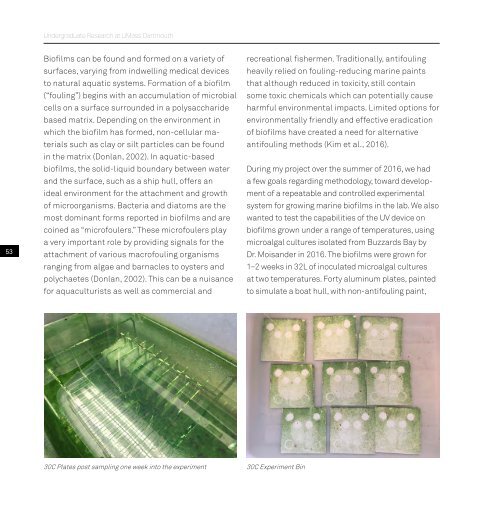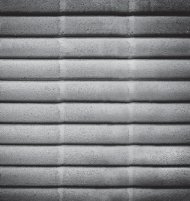Undergrad_Book_16-18_Pge_View_Print_no print marks_compressed
Create successful ePaper yourself
Turn your PDF publications into a flip-book with our unique Google optimized e-Paper software.
<strong>Undergrad</strong>uate Research at UMass Dartmouth<br />
53<br />
Biofilms can be found and formed on a variety of<br />
surfaces, varying from indwelling medical devices<br />
to natural aquatic systems. Formation of a biofilm<br />
(“fouling”) begins with an accumulation of microbial<br />
cells on a surface surrounded in a polysaccharide<br />
based matrix. Depending on the environment in<br />
which the biofilm has formed, <strong>no</strong>n-cellular materials<br />
such as clay or silt particles can be found<br />
in the matrix (Donlan, 2002). In aquatic-based<br />
biofilms, the solid-liquid boundary between water<br />
and the surface, such as a ship hull, offers an<br />
ideal environment for the attachment and growth<br />
of microorganisms. Bacteria and diatoms are the<br />
most dominant forms reported in biofilms and are<br />
coined as “microfoulers.” These microfoulers play<br />
a very important role by providing signals for the<br />
attachment of various macrofouling organisms<br />
ranging from algae and barnacles to oysters and<br />
polychaetes (Donlan, 2002). This can be a nuisance<br />
for aquaculturists as well as commercial and<br />
recreational fishermen. Traditionally, antifouling<br />
heavily relied on fouling-reducing marine paints<br />
that although reduced in toxicity, still contain<br />
some toxic chemicals which can potentially cause<br />
harmful environmental impacts. Limited options for<br />
environmentally friendly and effective eradication<br />
of biofilms have created a need for alternative<br />
antifouling methods (Kim et al., 20<strong>16</strong>).<br />
During my project over the summer of 20<strong>16</strong>, we had<br />
a few goals regarding methodology, toward development<br />
of a repeatable and controlled experimental<br />
system for growing marine biofilms in the lab. We also<br />
wanted to test the capabilities of the UV device on<br />
biofilms grown under a range of temperatures, using<br />
microalgal cultures isolated from Buzzards Bay by<br />
Dr. Moisander in 20<strong>16</strong>. The biofilms were grown for<br />
1–2 weeks in 32L of i<strong>no</strong>culated microalgal cultures<br />
at two temperatures. Forty aluminum plates, painted<br />
to simulate a boat hull, with <strong>no</strong>n-antifouling paint,<br />
30C Plates post sampling one week into the experiment<br />
30C Experiment Bin



